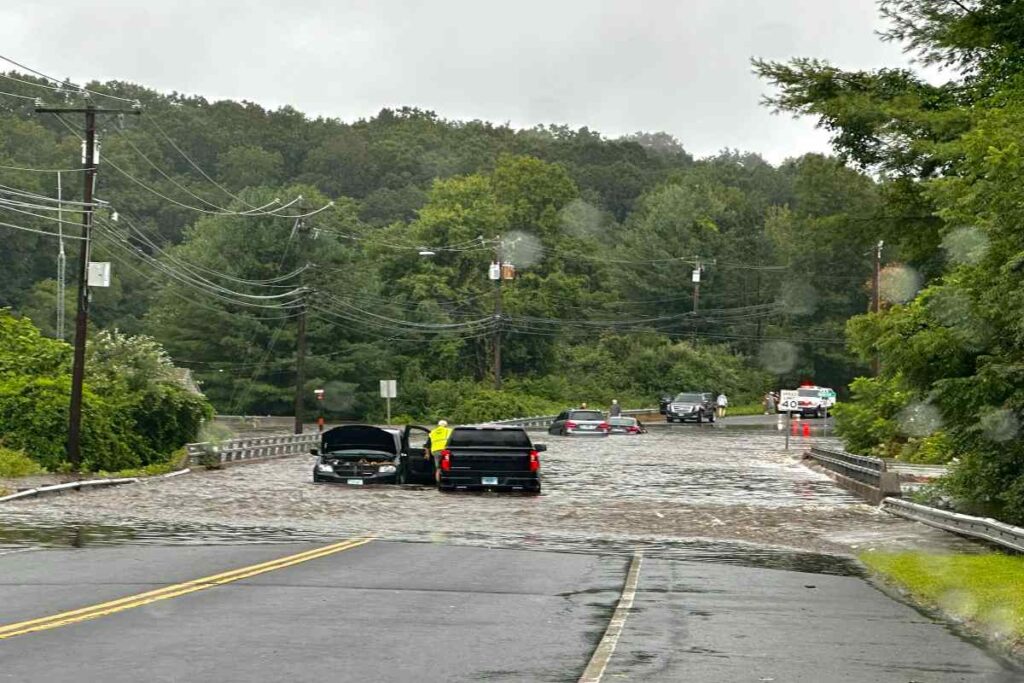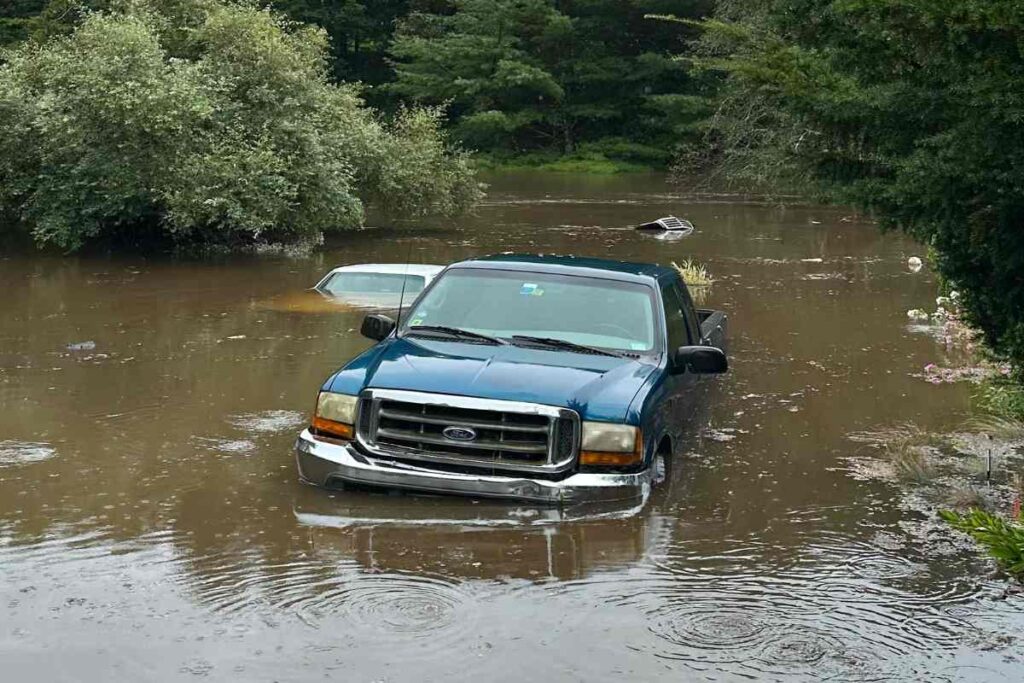
Following a heavy downpour of rain between August 16 and 18, 2024, Connecticut has suffered devastating flooding. Consequently, cleanup works have started to calculate the infrastructure damage and remove debris from damaged roads and bridges.
On Sunday, August 18, 2024, Governor Ned Lamont of Connecticut issued a state of emergency after the flooding that hit western Connecticut. Additionally, two bodies were discovered following the heavy rain that forced over 100 evacuations in Connecticut.

Where in Connecticut Was the Flooding?
On Monday, August 19, 2024, it was announced that the flooding had devastated western Connecticut. In the aftermath of the flooding in Oxford, emergency services carried out rescue missions, saving over 12 people.
However, on Route 67, some 15 miles northwest of New Haven, two women, ages 65 and 71, were carried away in the flooding. William Turner, the Director of Connecticut State Emergency Management, confirmed the deaths.
ALSO READ: Heavy Flooding Leaves Thousands Without Power Across Northeast
On Monday, August 18, 2024, Turner reported that the women’s bodies had been recovered from the Little River. The flood victims had been in their vehicles when they were swept away. Responding to the growing panic in Connecticut, its governor, Ned Lamont, issued a state of emergency.
Lamont said, “The sudden and severe flooding has caused significant damage to infrastructure in the western portion of the state, resulting in evacuations, rescues, and more than two dozen road closures that we anticipate will need to be closed for an extended period.”
Subsequently, Turner revealed that numerous amounts of distress have been sent out to emergency services, mostly from southwestern Connecticut. Although flooding was reported in Stamford in the Interstate 95 corridor, the rural areas took the worst of all.
Speaking on the severity of the flooding, Turner said, “The heaviest rains seem to have set up from Monroe up into Beacon Falls and some more rural parts of the state, but away from our major highways like I-95 and I-8.”
Turner added, “But nonetheless, we still have extensive damage to a lot of state and local roads that we’re out there assessing now to determine the impact and to see what we’ll need to do to get them reopened.”
What Was the Biggest Flood in CT?
Connecticut has had its history of floods, but the worst flood that Connecticut has ever witnessed came in 1955. In August 1955, two consecutive hurricanes soaked the state’s land and various river valleys, resulting in significant flooding.
The flooding severely affected rivers such as the Quinebaug, Naugatuck, Farmington, and Mad Rivers. Towns such as Farmington, Putnam, Waterbury, and Winsted experienced significant losses.
POLL—Should Public Schools Include Critical Race Theory and Sex Education in Their Curriculum?
According to data from 1955, the flooding claimed the lives of almost 90 individuals and caused more than $200 million in property damage statewide. The floods ensure the implementation of modifications to zoning regulations, safety protocols, and river monitoring.
According to a Sunday Herald reporter, the flooded area of Connecticut was “a staggering toll of death in a shroud of mud.” The flooding resulted in 87 deaths, both directly and indirectly.
The damages to industrial and commercial establishments amounted to $133.9 million. Additionally, the flooding affected 922 farms, which put the loss and damages to $2.5 million. The damage to public property was estimated at $36.8 million.

Where Was the Biggest Flood in the United States?
In America, massive floods have always occurred in areas near large river systems, like Mississippi and Missouri. In 1927, there was a record amount of rain, causing the Mississippi’s levees to fail.
The failure resulted in the deaths of 246 people and the flooding of over 27,000 square miles across 7 states. The Midwest Floods of 1993 resulted in the deaths of 48 people and property damage of $30.2 billion.
With an above-average snowpack and above-average precipitation, 2011 was a historic year for flooding. The flooding in the Missouri River valley is believed to have cost over $2 billion, destroying over 4,000 homes and claiming five lives.
Flooding along the Mississippi River reached historic levels, resulting in at least 7 deaths, with the cleanup after destruction estimated to be around $3–$4 billion.
The levees in New Orleans broke during Hurricane Katrina in 2005, and the Mississippi River Gulf Outlet flood effects resulted in $133.8 billion in damages and the deaths of 1833 people.
WATCH: Is Ozempic Face a Myth or a Fact? How the Weight Loss Drug Alters People’s Looks

What Year Did the Biggest Flood Occur for the Connecticut River?
On March 9, 1936, a warm, moisture-laden front stalled over New England, increasing temperatures. However, between March 11 and 13, 1936, New England witnessed heavy rainfall and increased temperatures.
Regarded as one of the biggest floods in the United States, the New England flood of 1936 was widespread following melting snow and persistent rain. Additionally, the passage of ice on the rivers and the ensuing ice jams and breaks caused great damage.
At Holyoke Dam, there is an illustration of the catastrophic ice damage. Originally, the Connecticut River had to create a new channel on the east bank of the river to get past an ice blockage above the dam.
You Might Also Like:
Daniela Larreal Chirinos Found Dead in Her Home After Choking on Food
Autumn McClure: 20-Year-Old Dies in Freak Accident While Driving With Boyfriend
Daytime Talk Pioneer Phil Donahue Dies at 88
Simon Cowell Set To Work With Domino’s As Quality Captain
Rare Oarfish Found Drifting off Southern California Coast by Snorkelers and Kayakers
